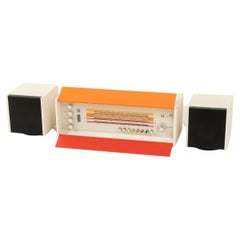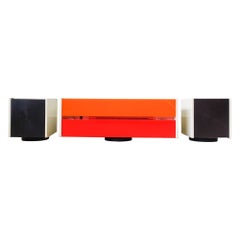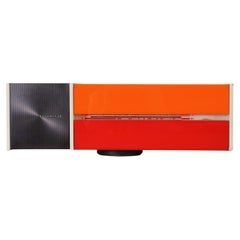Nordmende Spectra
Vintage 1970s German Mid-Century Modern Musical Instruments
Plaster
Recent Sales
Vintage 1960s German Mid-Century Modern Musical Instruments
Plastic, Wood
Vintage 1960s German Mid-Century Modern Musical Instruments
Metal
Vintage 1960s German Space Age Music Stands
Chrome
Vintage 1960s German Industrial Musical Instruments
Metal
People Also Browsed
Vintage 1960s French Mid-Century Modern Musical Instruments
Plaster
Vintage 1970s Italian Mid-Century Modern Bedroom Sets
Steel, Chrome
Vintage 1970s Italian Post-Modern Beds and Bed Frames
Wood, Elm
Vintage 1970s American Games
Metal
Vintage 1970s Italian Post-Modern Beds and Bed Frames
Steel, Chrome
Vintage 1960s Italian Mid-Century Modern Desk Sets
Metal
Mid-20th Century Swiss Mid-Century Modern Club Chairs
Leather
Vintage 1970s Italian Hollywood Regency Dry Bars
Brass, Steel, Chrome
Vintage 1960s Italian Post-Modern Vanities
Metal, Brass
Vintage 1970s Italian Mid-Century Modern Scientific Instruments
Metal
Vintage 1970s American Mid-Century Modern Commodes and Chests of Drawers
Plastic, Hardwood
Vintage 1970s French Mid-Century Modern Musical Instruments
Plaster, Wood
Antique Late 19th Century French Victorian Bookcases
Wood
Vintage 1970s German Mid-Century Modern Bathroom Fixtures
Chrome
Vintage 1950s Italian Screens and Room Dividers
Wood
Antique 19th Century Italian Apothecary Cabinets
Glass, Walnut
Raymond Loewy for sale on 1stDibs
For those in the know, French-born American industrial designer Raymond Loewy is the “father of streamlining.” He is widely recognized as a pioneer of industrial design consulting — a creative powerhouse who took aim at cluttered designs and simplified them. Loewy left his mark on everything from toothbrushes to trashcans to spacecraft interiors. He designed cars, worked in illustration, and crafted comely dressers and other furniture.
Loewy was born in Paris, France. At age 15, he designed a model airplane that was powered by rubber bands. It won the James Gordon Bennett Cup of 1908. Loewy patented the model kit for this plane by the following year and saw brisk sales. With his savings, Loewy was able to study at the University of Paris and then at Ecole de Lanneau, where he earned an engineering degree in 1918.
Loewy moved to New York City in 1919 and found work as a window designer for the department stores Macy's, Wanamaker's and Saks and as a fashion illustrator for Vogue and Harper's Bazaar. Loewy’s big break in industrial design came in 1929 when he altered the Gestetner duplicating machine — removing jutting parts and encasing the moving works in an understated cover. It caused a sensation within the industry — and companies began to call on him.
Loewy designed packaging for Coca-Cola and revised the look of Lucky cigarettes. The “Loewy Look,” which referred to the designer’s efforts to strip a product of any unnecessary detail and streamline its appearance, began to characterize hundreds of products.
Loewy found clients in a dizzying number of companies. He did everything from retooling logos to redesigning products. His 1934 Sears Coldspot refrigerator was a sleek innovation that broke sales records. His Pennsylvania Railroad locomotive resembled a speeding bullet and was the darling of the 1939 World’s Fair. Loewy even reworked shapes for snacks at Nabisco. By the time World War II gathered steam, Raymond Loewy Associates — the industrial design firm he founded — had been operating in a number of American cities. When Time magazine featured him on the cover in October 1949 — Loewy was not shy about publicity — his profile soared.
Loewy worked with Studebaker for decades. The success of their 1953 Starliner coupe was due to his revolutionary design, while their 1963 futuristic, fiberglass-bodied Avanti, which came with advanced safety features and materialized at a time when the company was experiencing financial hardship, was his crowning achievement for the maker.
Returning to his roots in aviation, Loewy worked for NASA from 1967 to 1973 on the interior design of the Skylab space station. He was also involved in the interior designs of the Concorde supersonic jet and Air Force One. Loewy delighted in creating furniture and collaborated with manufacturers such as Mengel Furniture, Rosenthal and Doubinsky Frères. In the 1970s, Loewy and his wife shuttered their businesses and retired in France.
On 1stDibs, find vintage Raymond Loewy cabinets, serveware, seating and more.
Finding the Right Musical-instruments for You
Pay tribute to a history of rich and diverse musical traditions that have taken shape all over the world by decorating your home with a collection of antique and vintage musical instruments.
Whether you’re playing them or merely displaying them, vintage musical instruments, when cared for properly, can be a wonderful addition to any space. At between four and five feet in length, an elegant early-1900s Steinway & Sons baby grand piano will undoubtedly steal the show if you’re thinking of yielding some precious real estate to one of these American classics, but maybe you’re simply shopping for art to warm the bare walls of your new apartment or weekend home.
For your living room, maybe you’ve already hunted down portraits by Gered Mankowitz, a celebrated 1960s-era photographer who spent his life capturing iconic images of music’s biggest stars. If you’ve got more space to work with there — or perhaps you need some entertainment room ideas — consider positioning an old guitar as a focal point. If a room has no distinguishing architectural features, you could create a prominent focal point with trending paint colors, stylish shelving, an arrangement of flowers or by wall-mounting a spectacularly aging early-20th-century guitar or other stringed instrument.
Alternatively, much in the way that you might group a collection of artwork to hang salon-style, with a little help from strong hanging wire or some wall hooks, vintage brass instruments such as a gong, French horn or trumpet can help elevate a home office or complement the efforts you’ve made to ensure a welcoming vibe in your home’s entryway. Bells or antique wind instruments can add provocative metallic contrasts to dark woods as tabletop decorative objects. Think of them as eye-catching ornamental flourishes that you can bring to end tables in a common area, to the top of a desk or to a mid-century storage cabinet.
Bring culture and creativity into your space with decades-old plywood tabletop radios or musical instruments from all over the world — be they drums from Africa or harps from France. Even if you’re not exactly getting the band back together, we can promise that the range of antique and vintage instruments on 1stDibs can help strike a meaningful chord in your interior design plan.
- What did Raymond Loewy design?1 Answer1stDibs ExpertFebruary 22, 2021Raymond Loewy is known as the father of industrial design. While he has designed razors, railroad terminals and more, Loewy is well known for notable logos such as the Lucky Strike cigarette packet and Coke bottle.


